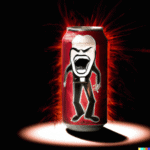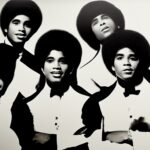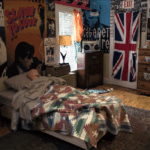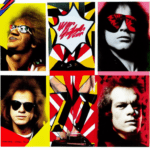As they say, all good things must come to an end. In the case of rock ‘n’ roll bands, they usually end with a bitter break up or a death. The list below looks at the final album by classic rock bands with their classic lineup intact. For the most part, the list will not include reunion albums years later with only some members, live albums post-break up, best of compilations or unreleased material compilations.
Led Zeppelin – In Through the Out Door (1979)
Ask any Zeppelin fan to pick their favorite album and you’ll hear many different answers; it could be Physical Graffiti, Led Zeppelin III or Houses of the Holy. The album you will not hear much is In Through the Out Door – Zeppelin’s final album. While most bands would call this their best album, it’s typically in the middle or end of the pack for fans and critics. Released in 1979, their eighth and final studio album held many highlights including “Fool in the Rain,” “In the Evening” and “All My Love.” The album was a success – hitting #1 on the album charts in the US and UK. The lone single – “Fool in the Rain” – was a hit in the US where it peaked at #21 on the Billboard Hot 100.
Unknown to the band at the time, In Through the Out Door, would be the final Zeppelin studio album as drummer John Bonham died unexpectedly just weeks before the band started their US tour. Three months after his death, the band officially called it quits.
In 1982, two years after disbanding, Coda was released. A collection of rarities and outtakes from their career, Coda was successful commercially as it landed in the Top 10album charts in the US and UK.
The Band – Islands (1977)
The Band’s debut in 1968 – Music from the Big Pink – was not your traditional group releasing their first album. From the early 1960’s, members of the Band had toured extensively as Ronnie Hawkins’ backing band and then did the same for Bob Dylan as he entered his electric phase. By the time of their debut, the Band were seasoned road veterans. Music from the Big Pink was a groundbreaking blend of country, roots and early rock stirred together in one pot. The album is still considered one of the best albums of the 1960’s – along with their second album The Band. From 1968-1975, the Band released six studio albums with mostly rave reviews from critics.
By 1977, the Band were planning their exit and with the farewell live album – The Last Waltz. In order to move over to Warner Brothers to release The Last Waltz, the Band needed to release one more studio album to fulfill their contractual obligation with Capitol Records. The Band pieced together Islands for 1977 release with mostly unreleased songs and a few new tracks. The album was met with very mixed reviews from critics. Fans also did not respond to the material as it was easily their least successful album commercially (peaking at #64 in the US and becoming their first studio album to not chart in Canada). The Last Waltz – released after Islands – is not considered as the swan song since it was a live album.
Variations of The Band reunited in 1993 for Jericho with original members Levon Helm, Garth Hudson and Rick Danko (and a contribution on one song from Richard Manuel). However, it is hard to call this an album by The Band in its original state without Robbie Robertson. The Band would reconvene for two more albums in the 90’s with High on the Hog (1996) and Jubilation (1998).
Creedence Clearwater Revival – Mardi Gras (1972)
Beginning in May 1968 with Creedence Clearwater Revival and ending in April 1972 with Mardi Gras, CCR recorded an astounding 7 albums in 4 years. Mardi Gras was the only album to not feature John Fogerty’s brother Tom. It is also notable as the only album to feature songwriting and singing from the three remaining members instead of only John Fogerty.
Reviews of the album were all over the board, but many critics bashed the album. Among the harshest critics were Rolling Stone Magazine’s Jon Landau saying in his May 1972 review “relative to a group’s established level of performance, the worst album I have ever heard from a major rock band.” Overall, the album was commercially successful achieving Gold Status in the US (500,000 units) and peaking at #12 on the US Billboard album charts. It was also a Top 10 album in many other countries including Australia, Germany, Italy and Japan. There were also two Top 40 singles from the album – including their last Top 10 hit in the US “Sweet Hitch-Hiker,” peaking at #6 and “Someday Never Comes” which peaked at #25 in the US. “Sweet Hitch-Hiker” was also a Top 10 single in many countries worldwide. In comparison, however, to their previous albums, Mardi Gras was a commercial disappointment ending their streak of six consecutive Platinum albums and 5 consecutive Top 10 albums in the US. In addition, in the UK, the album failed to chart after three consecutive Top 10 albums.
The Smiths – Strangeways, Here We Come (1987)
For a band that only existed as a recording unit for 4 years, the Smiths had a huge influence on rock and pop music. In fact, in terms of indie rock bands, the Smiths are one of the most influential bands ever. From their first single in May 1983 – “Hand in Glove” – to their final studio album in September 1987 – Strangeways, Here We Come – the band recorded some of the most essential music to ever come out of England.
During their existence, the Smiths built a cult following that was beginning to grow in the US. In fact, Strangeways, Here We Come peaked at #55 on the US Billboard album charts – by far their best showing. Meanwhile, in their home country the band was massively successful – releasing 15 Top 40 hits between 1983 and 1987 and all four studio albums reaching the Top 5 with 1985’s Meat is Murder reaching #1.
Since the breakup, the Smiths catalog has thrived with various compilations and live releases. Amazingly, the band has gained more popularity in the US in the years following their end.
The Police – Synchronicity (1983)
Some bands end their careers on a low note – having run out of creative ideas or just losing interest in the music created. In fact, the Police were riding a wave of success in the early 80’s with Zenyatta Mondatta and Ghost in the Machine both reaching Top 5 status in the US and UK.
With 1983’s Synchronicity, the Police ended on the highest note possible with the release of their fifth studio album. The album would not only become the best-selling album of their successful career; it was one of the most commercially successful albums of the decade. Synchronicity would sell more than 8 million copies in the US alone and would peak at #1 in the UK, Canada, Australia, Spain and the US. As for singles, the band would release four massive hits – “Every Breath You Take” (UK #1, US #1), “Wrapped Around Your Finger” (UK #7, US #8), “Synchronicity II (UK #17, US #16) and “King of Pain” (UK #17, US #3).
R.E.M. – Collapse into Now (2011)
Over 15 studio albums, R.E.M. went from a little college town band in Athens, GA to international superstars. What started out as everyone’s favorite college rock band, turned into seven Platinum albums and nine Top 40 singles in the US – including four Top 10 hits on the Billboard Hot 100. However, their success was not confined to their country; the band had huge success in the UK as well with eight #1 albums and an astounding 31 Top 40 singles. From their debut in 1983 with Murmur to the massive success of Out of Time (1991), Automatic for the People (1992) and Monster (1994), R.E.M. churned out records that delighted critics and fans alike around the world.
While Collapse into Now did not generate as much commercial success as their previous records, the album still had a strong showing peaking at #5 in both the US and UK and hitting #1 on the German and Switzerland album charts.
Grateful Dead – Built to Last (1989)
It’s hard to believe that more than 30 years have passed since the last Grateful Dead studio album. Over the esteemed career, the Dead have released more than 200 albums due to their massive live library. However, over a span of 22+ years, the Dead only released 13 studio albums including classics Workingman’s Dead, American Beauty and Terrapin Station. Most loyal followers – Deadheads – will tell you the studio albums could never capture the magic and freedom of the live shows so the studio albums were just opportunities to see their favorite band tour again.
Released in 1989, Built to Last was the follow up to 1987’s In the Dark – which was their most successful album to date selling more than 2 million copies in the US alone and peaking at #6 on the Billboard 200 becoming their only Top 10 album. In the Dark also contained their only Top 40 US hit with “Touch of Grey.” Building off their first mainstream commercial success, Built to Last would only certify Gold (500,000) in the US and did not serve up any follow up hit singles. The lack of commercial album and single success however was no indication of their live popularity as the Grateful Dead continued to play to sold out crowds every night as the premier live band in America pushed by the loyal Deadheads that followed them across the country.
The Dead continued touring until guitarist and vocalist Jerry Garcia passed away in 1995. Although they would never have an opportunity to hear more studio albums from their favorite band, Deadheads continued to receive releases in classic live recordings that spanned their decades long career. And through continued touring by other members of the band with spinoffs including The Other Ones, The Dead, Dead & Company, Furthur and many others. The Dead live on!
The Doors – L.A. Woman (1971)
In a span of 4 years from January 1967 – April 1971, the Doors released an astounding six studio albums – The Doors, Strange Days, Waiting for the Sun, The Soft Parade, Morrison Hotel and L.A. Woman. Although quantity was very high, the Doors also achieved both commercial and critical quality; all six records peaked in the US Billboard Top 10 and also did very well in Canada and France. They also achieved success with singles as well with 8 Top 40 hits in the US with songs such as “Light My Fire,” Hello, I Love You” and “Love Her Madly.” Unknown to the band at the time of the recording, L.A. Woman represented the final Doors album with lead singer Jim Morrison. Less than three months after the release of L.A. Woman, Morrison would die in a Paris hotel room leaving the other members – Ray Manzarek, John Densmore and Robby Krieger – without a lead singer and front man. L.A. Woman was another successful outing for the band – peaking at #9 on the US album charts (#11 in France, #4 in Canada and #1 in the Netherlands) and also generating two big hits in “Love Her Madly” and “Riders on the Storm.”
Although the remaining members did their best to carry on without Morrison with three follow up albums – Other Voices (1971), Full Circle (1972) and An American Prayer (1978) – the albums can hardly be considered as true Doors records without their lead singer.
Genesis – We Can’t Dance (1991)
By the time Genesis released their fourteenth studio album in 1991, five years had passed since their last album – the massively successful Invisible Touch (1986). The album generated five major hits including “Invisible Touch,” “Throwing it All Away,” “In Too Deep,” “Land of Confusion” and “Tonight, Tonight, Tonight.”
With five years in between records, many bands would be concerned that they faded from the spotlight and memory of fans. That was not the case for Genesis as their individual members – especially Phil Collins and Mike Rutherford – continued their commercial successes on other projects. In the time off, Rutherford’s side project – Mike + The Mechanics – released two albums, including the successful Living Years. The title track, released in 1989, became a worldwide hit – reaching Number 1 in Ireland, Australia, Canada and the US. Meanwhile, Phil Collins remained busy and successful (perhaps even more successful than Genesis at their peak) with the soundtrack for the 1988 movie Buster – which produced two massive hits with “Groovy Kind of Love” (UK #1 and US #1) and “Two Hearts (UK #6 and US #1). As if that wasn’t enough success during the downtime between albums by Genesis, Collins released the massively successful solo album …But Seriously. Released in November 1989, …But Seriously would hit Number One on the album charts in virtually every country that sold records and would yield an impressive four Top 5 Hits in the US, including the global smash “Another Day in Paradise.”
When We Can’t Dance was released in 1991, the world was ready and receptive. The album continued Genesis’ streak of Platinum records and would hit the Top 10 album charts around the globe. In addition, the singles continued to sell with five more US Top 40 hits, including the title track peaking at #7.
Collins left Genesis in 1996 and was replaced by lead singer Ray Wilson. Genesis would release one album with Wilson – 1997’s Calling All Stations. While the album sold well, it did not compare to the albums with Phil Collins at the helm.
Rush – Clockwork Angels (2012)
The kings of prog hard rock, Rush released 19 albums over their career beginning in 1974 with Rush. The band would achieve huge success over the next four decades with 13 Platinum albums in the US and massive success in their native Canada. The band, most known for their live shows, always pleased fans with their studio records from 2112 to Moving Pictures.
In 2012, they released what would become their final album – Clockwork Angels. The album landed in the #1 spot on the Canadian album charts making it the first Rush album to hit #1 since 1982’s Signals. Clockwork Angels was also successful in the US peaking at #2 on the Billboard 200. Although recording for the band had slowed considerably in the previous 10 years – having released only 2002’s Vapor Trails and 2007’s Snakes & Arrows – fans likely expected Rush would record another record eventually after Clockwork Angels. That was not to be the case as guitarist Alex Lifeson announced in 2015 that they band would not continue forward. Any hopes of a reuniting for an album were certainly dashed when drummer Neal Peart passed away in 2020.













